The Scottish Health Survey 2021 - volume 1: main report
Presents results for the Scottish Health Survey 2021, providing information on the health and factors relating to health of people living in Scotland.
Chapter 10 Injuries / Accidents
Chapter Summary
In 2021, the proportion of adults who reported having at least one accident in the previous 12 months has not changed since 2015.
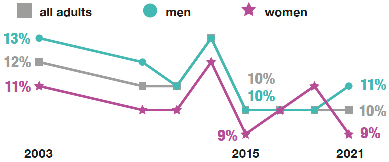
In 2019/2021 combined, men in the younger age groups were more likely than women to have had an accident in the previous 12 months.
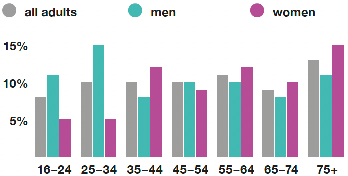
The proportion of children reporting one or more accidents during the previous 12 months in 2021 was lower than in previous years.
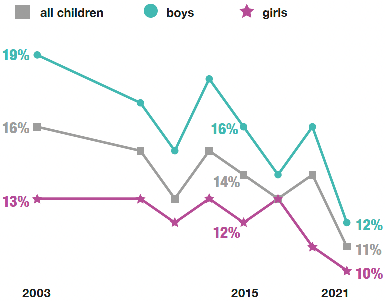
In 2019/2021 combined, accidents were most common among 14 to 15 year old children, with boys more likely to have had an accident in the last 12 months than girls.
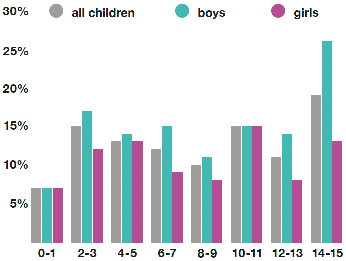
In 2019/2021 combined, the most common cause of accident was a fall, slip or trip for both adults and children who had one or more accidents in the last 12 months. Below are the top five reasons for accidents.
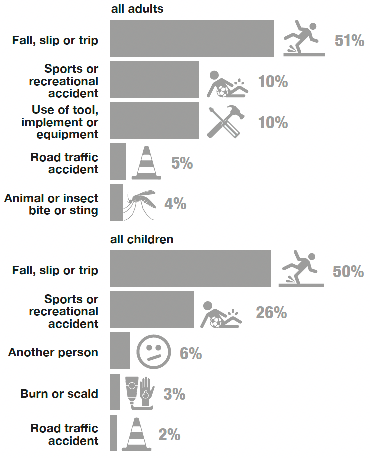
Injuries / Accidents
Rachel Whitford
10.1 Introduction
Injuries are a common cause of death among the Scottish population: approximately 1 in 23 adult and 1 in 13 child deaths in 2020 were caused by unintentional injury.[1] Emergency hospital admissions are frequently caused by unintentional injuries among both adults and children and while these can happen to people of any age, the elderly and children tend to be more vulnerable to these.[2]
The risk of death and severe injury is particularly high in such diverse areas as the home, leisure activities and sports, road transportation, the workplace and in connection with consumer products and services.[3]
10.1.1 Policy Background
The Scottish Plan for Action on Health and Safety[4] published in 2016 promotes good health and safety practice in Scotland with the goal of an integrated occupational health and safety system across Scottish workplaces. Scotland's Road Safety Framework to 2030[5] was published in 2021 with the vision for Scotland to have the best road safety performance in the world with targets for a 50% reduction in people killed or seriously injured. Fire safety is also a key area of policy focus.[6]
Accidental injuries can have a serious impact for injured persons and also for their families, colleagues and wider society, including the NHS. In recognition of this, the Scottish Government provides financial assistance and wider support to organisations such as the Royal Society for the Prevention of Accidents and Child Accident Prevention Trust, which seek to reduce the incidence of such events through evidence-based programmes of education and awareness-raising. These wide-ranging programmes address a range of settings and risks, with a particular focus on home safety.
Additionally, the Scottish Government has been assisting Public Health Scotland in their reform of the Healthy Working Lives Programme. This programme provides guidance and support to employers in how to protect and support the health of their employees and is being adapted to be more receptive to post-pandemic needs.
10.1.2 Reporting on accidents in the Scottish Health Survey
This chapter reports trends for prevalence of accidental events that resulted in injury or physical harm for adults and children and figures by age and sex for 2019/2021 combined. Causes of accidents among both adults and children by age and sex are also reported using combined 2019/2021 data, in both cases to increase the sample sizes available.
As many of the figures are based only on those who had an accident, to increase the sample size available for analysis data from the 2019 and 2021 surveys have been combined to enable more robust estimates to be presented.
For a detailed description of terminology used in this chapter and for further details on the data collection methods for accidents, please refer to Chapter 2, of the Scottish Health Survey 2021- volume 2: technical report.
Supplementary tables on accidents are also published on the Scottish Government website: Scottish Health Survey.
10.2 Injuries/Accidents
10.2.1 Prevalence of accidents among adults and children, 2003 to 2021, by sex
Adults
The prevalence of adults aged 16 and over experiencing one or more accidents in the past 12 months has remained stable between 2015 and 2021 at 10% each survey year. Prior to 2015, the prevalence rate was slightly higher, fluctuating between 11% and 13% since 2003.
In 2021, 11% of men had one or more accidents during the previous 12 months, compared with 9% of women but this difference was not significant. Over time, prevalence rate of accidents among adults between the sexes did not vary significantly.
Children
In 2021, the proportion of children who had had one or more accidents in the previous 12 months was 11%. This was the lowest prevalence of accidents among children since the time series began and was three percentage points lower than the previous survey year in 2019 (14%). In 2021, the prevalence of accidents among boys and girls was not significantly different (12% and 10% respectively). However, over time the gap in the prevalence of accidents between boys and girls has fluctuated, with prevalence tending to be slightly higher for boys than for girls. Figure 10A, Table 10.1
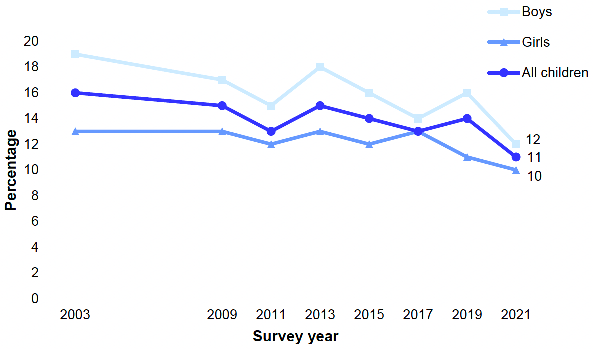
10.2.2 Prevalence of accidents among adults, 2019/2021 combined, by age and sex
In 2019/2021 combined, the proportion of adults who had one or more accidents during the previous 12 months did not vary significantly between age groups (lying between 8% and 13% for all age groups). However, the relationship between having one or more accidents in the past 12 months and age varied when examined by sex. In the younger age groups, men were more likely than women to have had an accident in the previous 12 months, most notably men aged 25-34 were more likely than women of the same age to have had an accident (15% and 5%, respectively). Figure 10B, Table 10.2
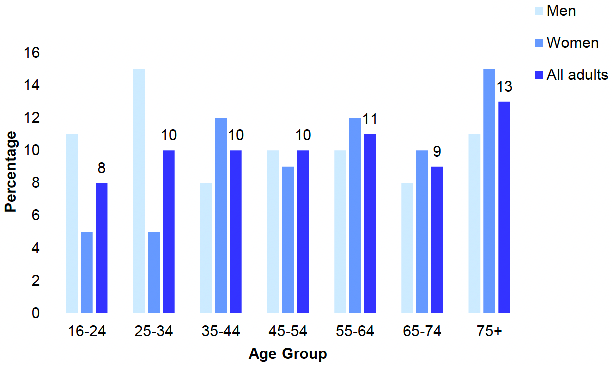
10.2.3 Prevalence of accidents among children, 2019/2021 combined, by age and sex
In 2019/2021 combined, the prevalence among children aged 0-15 of having one or more accidents in the previous 12 months varied significantly by age with children aged 14-15 (19%) significantly more likely than children aged 0-1 (7%) to have had an accident.
A significant difference was recorded by sex among those aged 14-15 with 26% of boys in this age group having had an accident in the last 12 months compared with 13% of girls of the same age. Figure 10C, Table 10.3
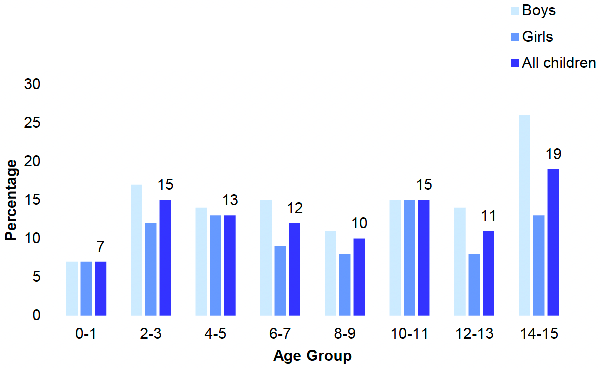
10.2.4 Causes of accidents, 2019/2021 combined, by age and sex
Adults
In 2019/2021 combined, the most common cause of accidents for all adults who had one or more accidents in the last 12 months was a fall, slip or trip (51%), followed by a sports or recreational accident (10%) and an accident caused by a tool, implement or equipment (10%). Smaller proportions reported that they had been involved in a road traffic accident (5%), an accident caused by another person (4%), an accident caused by an animal or insect bite or sting (4%), had been hit by a falling object (3%), had suffered a burn or scald (2%), or had had an accident caused by lifting (1%), while 12% reported other causes.
The most common cause of accidents among both women and men was a fall, slip or trip, however there was a higher prevalence rate among women than among men (60% compared with 42%, respectively). Men were more likely than women to have a sports or recreational accident, with 17% of males who had an accident in the last 12 months reporting this compared with 4% of females. This was also the case for adults who had an accident involving a tool, implement or equipment (14% of men who had an accident in the past 12 months compared with 6% of women). Figure 10D, Table 10.4
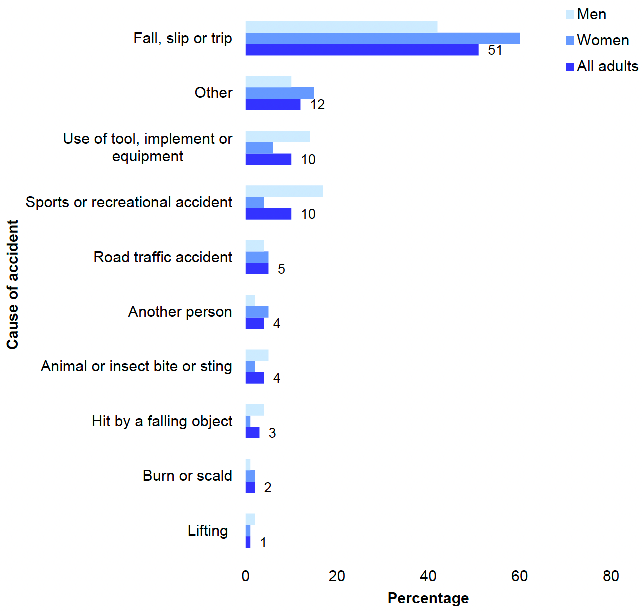
Children
As with adults, the most common cause of accidents among children (aged 0-15) in 2019/2021 was a fall, trip or slip, which was experienced by half of those (50%) who had one or more accidents in the past 12 months. The second most common cause of accidents was from a sport or recreational activity, which was the case for around a quarter (26%) of all children who had an accident, followed by an accident caused by another person (6%).
Similarly to adults, girls were more likely to have experienced a fall, trip or slip (57% of girls compared with 46% of boys), while boys were more likely to have had a sport or recreational accident (29% of boys and 21% of girls). Boys were also more likely than girls to have had an accident caused by another person, with 8% of boys who had an accident reporting this as the cause compared with 2% of girls.
By age
In 2019/21, out of all people (those aged 0+) who had had one or more accidents involving a fall, slip or trip in the last 12 months, the highest proportions were among the highest and youngest age groups (75% of those aged 65+ and 66% of those aged 0-7). Of those who had an accident caused by a sport or recreational activity, the prevalence rate was highest among those aged 8-15 (39%), followed by those aged 16-44 (19%). Table 10.4
Table list
Table 10.1 Prevalence of accidents among adults and children, 2003 to 2021, by sex
Table 10.2 Prevalence of accidents among adults, 2019/2021 combined, by age and sex
Table 10.3 Prevalence of accidents among children, 2019/2021 combined, by age and sex
Table 10.4 Causes of accidents, 2019/2021 combined, by age and sex
The tables can be found on the main report page under supporting files.
References
1. See Unintentional Injuries in Scotland.
2. See Unintentional Injuries.
3. See Injuries: introduction.
4. Scottish Government (2016). A Scottish Plan for Action on Safety and Health: 2016 and beyond.
5. Transport Scotland (2021). Scotland's Road Safety Framework to 2030.
6. See Fire and rescue framework 2022.
Contact
There is a problem
Thanks for your feedback